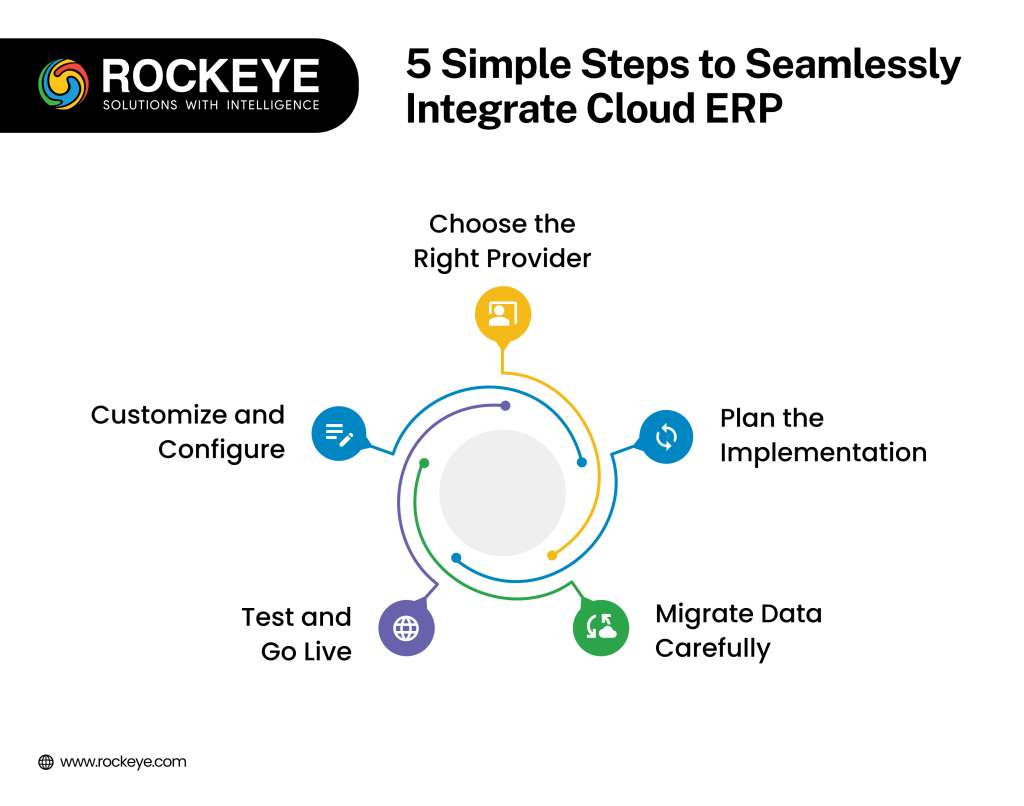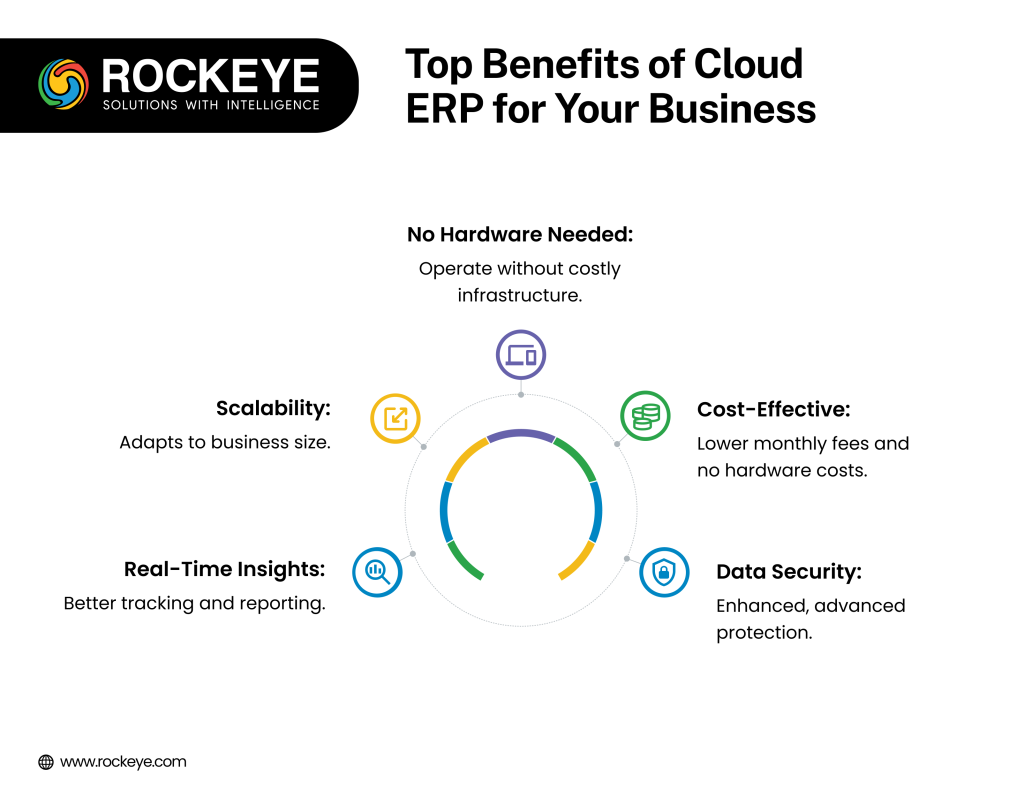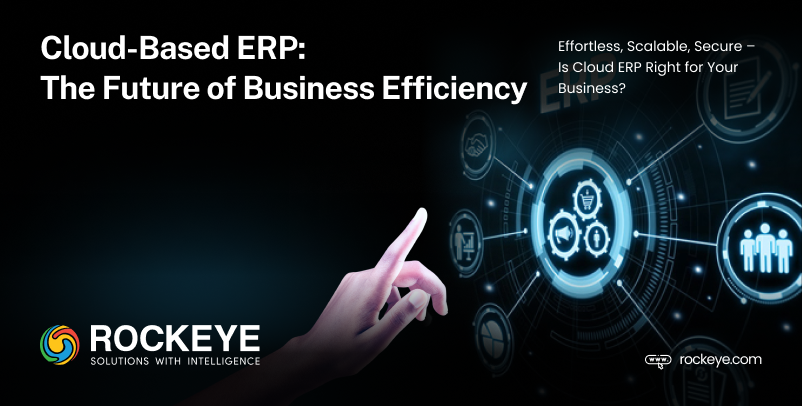Cloud-based ERP systems are becoming an increasingly popular choice for enterprises of all sizes. But what exactly are cloud-based ERP systems, and why should you consider them for your company? In this blog, we’ll cover the fundamentals of cloud-based ERP software and provide you with all the information you need to determine whether it’s the right fit for your business.
Let’s start by understanding what ERP is.
What Is ERP?
Enterprise Resource Planning, or ERP, software is a type of technology used as an integrated system within an existing business operation.
- With the help of ERP software, business organizations can automate multiple functions.
- It removes most of the manual work, such as accounting, supply chain management, and payroll management, improving the overall operation of the business.
With the development of technology and a futuristic approach, ERP has evolved into a cloud system, commonly known as cloud-based ERP software.
The advantage of cloud ERP software is that it is a hardware-free system that only needs to be installed on your computer, laptop, or mobile device.
How to Integrate Cloud based ERP System With Other Systems?

The role of cloud ERP is to work with your existing business setup and improve the system. Applying and integrating a cloud-based ERP software into the current business system is flexible and easy. The following are ways you can integrate a cloud ERP system.
- Choosing a suitable company to provide cloud ERP software is the initial step to start the integration process. It is not hard to choose, but you should worry about particular areas depending on the needs. One of the most important things you have to do is to take your time considering a vendor to implement the ERP system for you.
- After selecting the provider, the next most important thing is to plan the implementation process. For this, you need to have a budgeted plan and need to deliberate on the process and the resources required with your software provider.
- The third and most important step towards integrating cloud ERP software is to do the migration of data with caution. This is a point where duplication, distortion of data, and all such disruptions related to data are high.
- Fourthly, you need to mold your software to suit your needs and integrate it with your existing system. You will be configuring and personalizing the cloud ERP software to merge seamlessly into your ongoing business processes.
- Lastly, you need to test your software by checking whether it is performing well as planned, before going live with it. You shall notice during the testing period some of the problems and congestions that have to be rectified.
What Are the Benefits of Having Cloud ERP?

What do businesses need most? Time. Cloud ERP software is that kind of business solution system through which owners can save ample time and, along with that, reduces the wastage caused by unnecessary costs. See below some of the benefits it has on business:
- You can take away the hassle of having a hardware setup with cloud ERP software. No infrastructure is required, and hence it saves office space also. Cloud software can be brought into practice simply by installing it in your system.
- Whether you analyze the monthly fee or the money spent to buy hardware, cloud ERP software is economical from both angles. The monthly subscriptions of cloud ERP software are low, and since no hardware equipment is required for its integration, therefore no extra cost of infrastructure gets added in the budget.
- One of the major reasons most people shift towards cloud systems is because of their highly advanced features in terms of data security. The cloud-based ERP software provides a highly enhanced data protection system to businesses, which keeps them out of the reach of being hacked or disrupted by any third-party organization.
- Receiving real-time reports and tracking helps any business to function with more clarity and efficiency.
- Scaling with cloud ERP software is easy and cooperative. Depending on the size of the business, it can adjust the infrastructure in the cloud software, which helps in development.
How to Justify the Return on Investment of ERP?
Whether you are deploying cloud ERP software or on-premise ERP software, a basic upfront cost is always there for any business to incur. A return on investment analysis is thus needed to ascertain the cost to be incurred and project a suitable business plan to ensure profitability.
Here are the following ways to increase the ROI for a business:
- You can measure the operating expenses of the business before going live with cloud ERP software. Keeping track of the inventory, resources, machines, etc., helps you in monitoring the workflow of the business and helps you in reducing the operating costs if needed.
- Cloud-based ERP software is an advanced tool that enhances the productivity of the business. You can ascertain the performance and analyze the revenue the business is generating with the help of ERP and structure the ROI of the business.
- Advanced ERP software helps you in taking some productive decisions for your business. You can utilize your resources efficiently which elevates the productivity of the company.
- You can manage your operations effortlessly with the help of cloud-based ERP software. It gives you a clear picture of your supply chain and other business processes and delivers better insights into how each process is performing. Thus, efficient management saves enough money and time involved and plans a better return on your investment.
- If you have all your data in one place, you can compare the two and come to a more productive conclusion. ERP software helps in centralizing your data and makes your analysis easier and more effective in taking better business decisions.
Calculating the ROI of Cloud ERP
The calculation of ROI is done by comparing the implementation cost of cloud ERP software with the benefits the company would gain from the implementation.
The higher the ERP returns relative to the cost, the more beneficial it is for the business.
You can get a much clearer view of the company’s productivity and make long- or short-term decisions accordingly with the help of the calculation.
There are two factors involved in calculating the ROI of cloud-based ERP software:
- The returns generated from ERP.
- The cost involved in implementing ERP.
Here are the simple steps by which you can calculate the ROI:
- Estimate the direct & indirect benefits your organization is getting for the calculation of the ERP returns
- To calculate the ERP cost, evaluate the expenses involved while implementing cloud ERP software and the resources needed.
- Lastly, divide the returns by the cost and get your desired ROI result.
Before you calculate the ROI by following these 3 steps, it is important to consider the following factors first:
- Organize your data and analyze it with other departments for accuracy. For this, you will be needing a large chunk of data which will be daunting and time-consuming.
- Focus on how cloud ERP software will simplify the workflow process and increase the productivity of the employees who are using it.
- You must consider the time and effort required during the implementation process. The implementation cost and time should also be included while calculating ROI within a specific time.
- Considering the cost of ERP software is important during the calculation of ROI. Whether it is the hardware cost or the subscription cost, you must ascertain both and compare them with the returns it is providing.
Conclusion
It is vital to know the setup and the various nature of costs involved in implementing cloud-based ERP software while calculating its ROI. The implementation process could be a costly affair depending on the process which highly impacts the ROI calculation. Normally the implementation process of ERP software takes around 6-8 months which is quite lengthy. During this phase, apart from direct cost, the workflow gets hampered, the customization might get complex, and the data to be migrated might face disruptions. So overall, these little disturbances are also hampering the cost, which is incurred indirectly. Thus, it is important to find ways to reduce the implementation process, so that most of the mentioned issues could be averted.
ROCKEYE requires no more than a week for implementation, providing a swift setup that helps avoid workflow issues and disruptions that could impact operational efficiency. These and other benefits make ROCKEYE one of the leading cloud-based ERP solutions available today.

FAQs
1. What is a Cloud-Based ERP System?
A cloud-based ERP (Enterprise Resource Planning) system is an integrated software solution that helps businesses automate key functions like accounting, payroll, and supply chain management. Unlike traditional ERP systems, cloud-based ERP doesn’t require hardware installations; it only needs to be set up on computers, laptops, or mobile devices, making it flexible and accessible.
2. How Does Cloud ERP Integration Work?
Integrating cloud ERP with your existing business setup is straightforward. The process generally involves:
- Selecting a reliable ERP provider that aligns with your needs.
- Planning the implementation process, including budget and resources, with your software provider.
- Carefully migrating data to avoid duplication or data errors.
- Customizing the software to match your business processes.
- Testing the system to ensure everything functions correctly before going live.
3. What Are the Main Benefits of Cloud ERP for Businesses?
Cloud ERP offers several advantages, including:
- No hardware requirement: It saves on infrastructure costs and frees up office space.
- Cost-effective: With lower monthly subscriptions and no hardware expenses, it’s economical for businesses.
- Enhanced data security: Cloud ERP provides advanced data protection against unauthorized access or cyber threats.
- Real-time reporting: Access to live data and analytics enables businesses to make timely, informed decisions.
- Scalability: Cloud ERP can adapt to business growth, adjusting its infrastructure as needed.
4. How Can Cloud ERP Improve My Business’s ROI?
Cloud ERP systems enhance ROI by:
- Helping track and reduce operational costs through better resource management.
- Boosting productivity by streamlining workflows and automating tasks.
- Centralizing data to provide insights and enable data-driven decisions.
- Allowing for efficient management of the supply chain and other processes, saving time and money.
5. How Do I Calculate the ROI of a Cloud-Based ERP?
To calculate ROI, compare the costs of ERP implementation with the benefits achieved. Here’s a simple breakdown:
- Estimate benefits: Identify direct and indirect gains from ERP, like reduced costs and time savings.
- Calculate ERP costs: Factor in all expenses related to ERP implementation, including software and any additional resources.
- Divide benefits by costs: This gives the ROI percentage, showing how effectively the ERP investment is contributing to profitability.
- business automation
- cloud ERP
- cloud ERP advantages
- cloud ERP flexibility
- cloud ERP implementation
- cloud ERP ROI
- cloud-based ERP
- enterprise resource planning
- ERP benefits
- ERP centralization
- ERP cost savings
- ERP cost-effectiveness
- ERP data security
- ERP decision-making
- ERP for businesses
- ERP implementation steps
- ERP infrastructure
- ERP integration
- ERP migration
- ERP productivity
- ERP software
- ERP subscription
- ERP vendor selection
- ERP workflow efficiency
- real-time reporting
- ROCKEYE ERP
- ROI calculation
- scalable ERP

